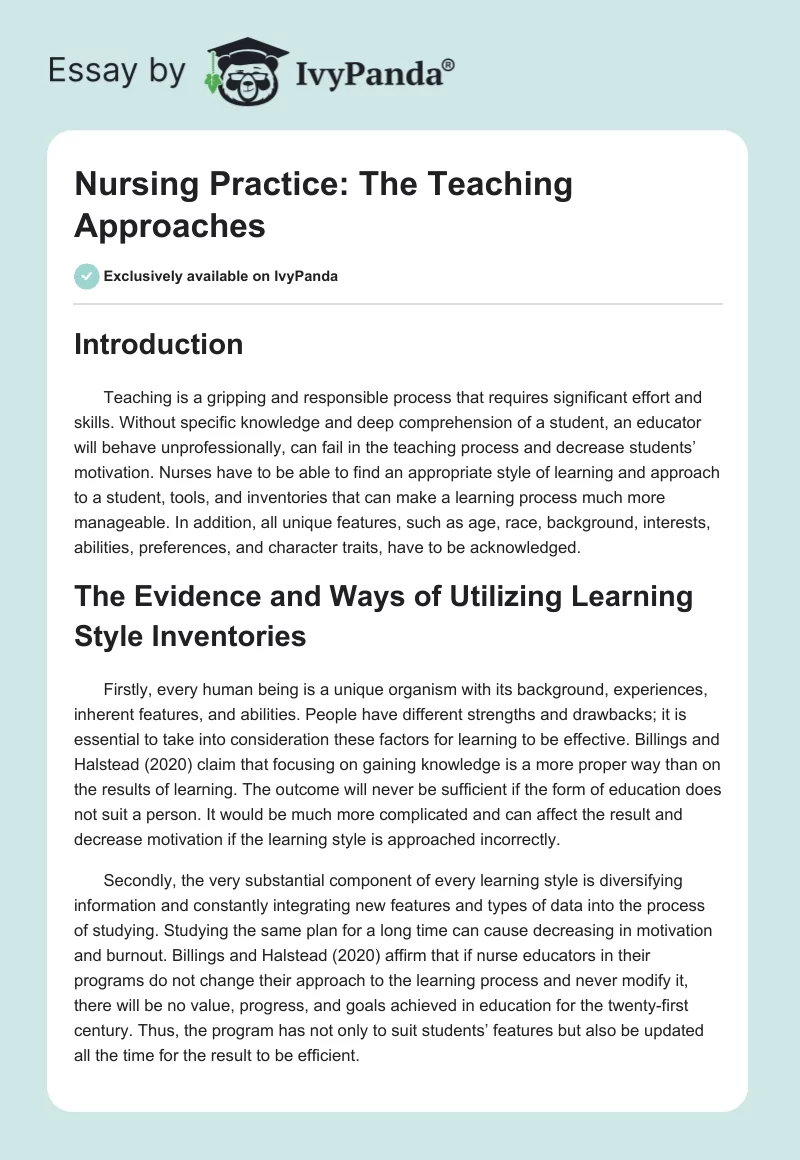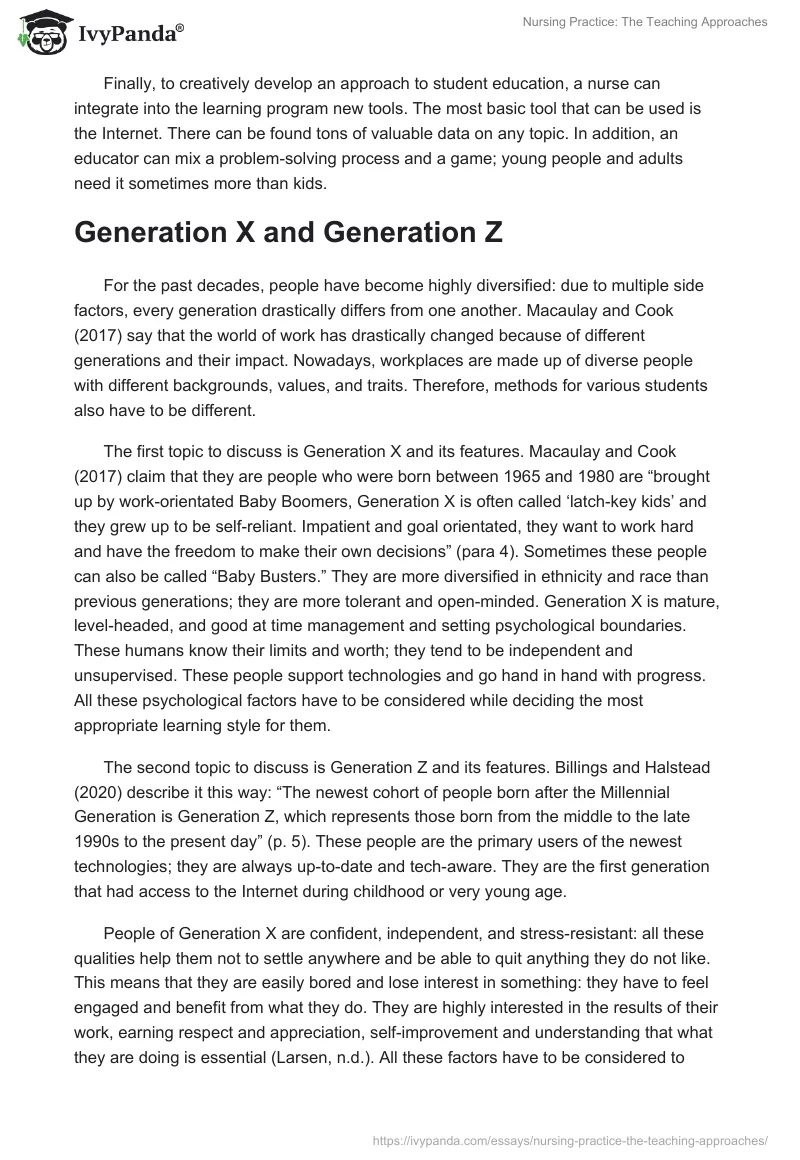Introduction
Teaching is a gripping and responsible process that requires significant effort and skills. Without specific knowledge and deep comprehension of a student, an educator will behave unprofessionally, can fail in the teaching process and decrease students’ motivation. Nurses have to be able to find an appropriate style of learning and approach to a student, tools, and inventories that can make a learning process much more manageable. In addition, all unique features, such as age, race, background, interests, abilities, preferences, and character traits, have to be acknowledged.
The Evidence and Ways of Utilizing Learning Style Inventories
Firstly, every human being is a unique organism with its background, experiences, inherent features, and abilities. People have different strengths and drawbacks; it is essential to take into consideration these factors for learning to be effective. Billings and Halstead (2020) claim that focusing on gaining knowledge is a more proper way than on the results of learning. The outcome will never be sufficient if the form of education does not suit a person. It would be much more complicated and can affect the result and decrease motivation if the learning style is approached incorrectly.
Secondly, the very substantial component of every learning style is diversifying information and constantly integrating new features and types of data into the process of studying. Studying the same plan for a long time can cause decreasing in motivation and burnout. Billings and Halstead (2020) affirm that if nurse educators in their programs do not change their approach to the learning process and never modify it, there will be no value, progress, and goals achieved in education for the twenty-first century. Thus, the program has not only to suit students’ features but also be updated all the time for the result to be efficient.
Finally, to creatively develop an approach to student education, a nurse can integrate into the learning program new tools. The most basic tool that can be used is the Internet. There can be found tons of valuable data on any topic. In addition, an educator can mix a problem-solving process and a game; young people and adults need it sometimes more than kids.
Generation X and Generation Z
For the past decades, people have become highly diversified: due to multiple side factors, every generation drastically differs from one another. Macaulay and Cook (2017) say that the world of work has drastically changed because of different generations and their impact. Nowadays, workplaces are made up of diverse people with different backgrounds, values, and traits. Therefore, methods for various students also have to be different.
The first topic to discuss is Generation X and its features. Macaulay and Cook (2017) claim that they are people who were born between 1965 and 1980 are “brought up by work-orientated Baby Boomers, Generation X is often called ‘latch-key kids’ and they grew up to be self-reliant. Impatient and goal orientated, they want to work hard and have the freedom to make their own decisions” (para 4). Sometimes these people can also be called “Baby Busters.” They are more diversified in ethnicity and race than previous generations; they are more tolerant and open-minded. Generation X is mature, level-headed, and good at time management and setting psychological boundaries. These humans know their limits and worth; they tend to be independent and unsupervised. These people support technologies and go hand in hand with progress. All these psychological factors have to be considered while deciding the most appropriate learning style for them.
The second topic to discuss is Generation Z and its features. Billings and Halstead (2020) describe it this way: “The newest cohort of people born after the Millennial Generation is Generation Z, which represents those born from the middle to the late 1990s to the present day” (p. 5). These people are the primary users of the newest technologies; they are always up-to-date and tech-aware. They are the first generation that had access to the Internet during childhood or very young age.
People of Generation X are confident, independent, and stress-resistant: all these qualities help them not to settle anywhere and be able to quit anything they do not like. This means that they are easily bored and lose interest in something: they have to feel engaged and benefit from what they do. They are highly interested in the results of their work, earning respect and appreciation, self-improvement and understanding that what they are doing is essential (Larsen, n.d.). All these factors have to be considered to adjust a program to them. The material must be relevant, the learning process has to give results, and the student has to feel needy and feel their contribution to something big. In addition, a great thing would be to provide “latch-key kids” enough freedom and let them do it in their unique, creative way.
Styles of teaching Millennials is a very relevant and essential topic nowadays. Billings and Halstead (2020) are sure that the implications of the Generation Z demographics have to be necessary to nursing faculty, and “teaching strategies that successfully engage the Millennial learner need to be interactive, group-focused, objective, and experiential” (p. 75). Professional combining education with entertainment will be the most efficient for these people. In addition, using such tools, such as presentations and videos from the Internet, integrating social media into studying will be highly convenient and beneficial. Moreover, the generation gap between teacher and student has to be considered. Younger people need the information to be explained concisely, specifically, and they gain appropriate feedback from the person who teaches them. Also, younger generations appreciate and respect mentoring from older students. They value the older generation’s knowledge and want to be helped (Starlink Professional Development, 2010). In addition, new approaches to style learning for Generation Z are still developing every day. To summarize, young people need an educational process to be diversified, interactive, modern, specific, experimental, engaging, with good feedback when it is required and mentorship.
Learning Strategies
The first thing that has to be implemented before the education process is the student’s readiness to learn. The first strategy for successful learning is bringing the class into focus. It is beneficial to start a process with exercises such as asking a student to highlight the best moments from their day/weekend/evening or revise some exciting material from the previous lesson (Open LMS, 2021). Moreover, it is possible to ask some extraordinary questions to draw every student’s attention and activate their brains toward thinking.
The second strategy for successful learning is developing basic cognitive skills. Good cognitive skills are a foundation for the effective digestion of information. To develop these skills, a person has to train their brains regularly and consume new information properly, with regular breaks. There are multiple online courses that can help any student develop reading, language skills, thinking, and remembering gradually. Memory is a crucial tool for learning; that is why consistency in brain training is fundamental. In addition, such type of exercises has to be gripping, including pictures, videos, songs, graphics, animation, etc.
The third strategy for successful learning is to set a good rapport with students and evoke trust in them. Educator’s intentions always have to be precise; an essential thing for a student is to trust the authority. A person has to feel safe, accepted, respected, appreciated, and feel the right to make mistakes. This will increase the level of a student’s readiness for the learning process and even motivation.
To increase an adult student’s motivation, an educator has to use relevant material. McCall et al. (2018) claim that students will be self-motivated if they are interested in the program and it is relevant to them, their past experiences, and future goals, and they are encouraged to connect with and reflect on the material (p. 38). Thus, the main points to motivate an adult student are integration, involving a learner in the process, making them actively participate, and not letting them be bored; showing the value and importance of the material they learn and how it can be beneficial in future, reflecting on material, discussing it, especially in groups.
Another strategy that can increase students’ motivation is to make the learning process easier. Having breaks when a student feels tired and less concentrated is very important for getting better results. Every 40 minutes to one hour, the brain needs a rest to reset and recover its power. The best way to rest during the break is to do physical activities: it can be anything that springs to mind. Open LMS (2021) writes that “movement is one way to effectively enhance cognitive functions” (p. 8). Thus, making the body move, exercising, or stretching will boost energy, motivation, and learning ability.
Educating Americans with Disabilities
Fundamentally, in educating people with disabilities, a teacher must know how to provide a student with first aid. A teacher has to be well aware of a kind of disorder, its aspects, and what can help in an emergency. The program and learning pace have to perfectly meet the student’s needs, considering all their features. In addition, the learning process, extracurricular activities, and accommodations have to be accessible to people with disabilities (ADA National Network, 2020). ADA affects learning well, adjusting every circumstance to be convenient and appropriate for everybody.
Furthermore, a psychological aspect is crucial in such type of education. People with disabilities encounter a significant amount of discrimination on a daily basis. Educator’s aim is at the same time to respect all student’s needs and treat them like ordinary ones: do not single them out from others. These people want to feel participation and connection to society and be free to learn, create and interact with the world. The critical point is to make learning accessible to them, support them, and encourage them to act, develop, and be confident.
Conclusion
In conclusion, nurses have to be able to find an appropriate style of learning and approach to a student, tools, and inventories that can make a learning process much more manageable. In addition, all unique features, such as age, race, background, interests, abilities, preferences, and character traits, have to be acknowledged. Teaching aims to make the learning process easier, more efficient, pleasant, and accessible to every student.
References
ADA National Network. (2020). What are a public or private college-university’s responsibilities to students with disabilities? Web.
Billings, D.M., & Halstead, J.A., (2020). Teaching in nursing. A guide for faculty (6th ed.). Saunders.
McCall, R. C., Padron, K., & Andrews, C. (2018). Evidence-based instructional strategies for adult learners: A review of the literature. Bronx Community College, 4(4), 27-47.
Larsen, B. (n.d.). Understanding gene+rational differences in education. Career Services and WSU, 1-64. Web.
Macaulay, S., & Cook, S. (2017). Learning development: Across the generations.Training Journal. Web.
Open LMS (2021). Learner readiness: 5 tips to help learners improve their focus. Web.
Starlink Professional Development. (2010). Learning styles: Generational teaching tips [Video]. YouTube. Web.


